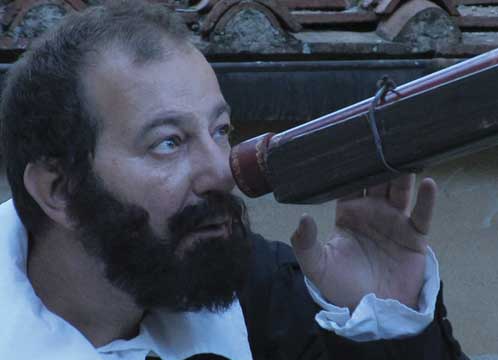 Winter 2008
Winter 2008|
Stay tuned: As part of the International Year of Astronomy, Carnegie Science Center will offer a different astronomy program each month in 2009—from special stargazing opportunities in the observatory to lectures and special programs in the Buhl Digital Dome. And don’t miss the current exhibit, Hubble Space Telescope: New Views of the Universe.
|
A new Buhl Planetarium show is set to recount the day—400 years ago—that our fascination with the night sky turned into something truly out-of-this-world.
 A scene from Two Small Pieces of Glass, set to debut at Buhl Digital Dome in April.Nearly 400 years ago, Galileo turned a telescope to the night sky and gazed at the moon. Beyond it, Jupiter loomed in his view. Focusing on the giant planet, he noticed three bright bodies, which he assumed were stars. After night fell the following day, Galileo returned to his telescope, and this time he realized the bright bodies moved with Jupiter, meaning they couldn’t be stars. Night after night for a week, Galileo trained his scope on the massive planet to decipher the mystery. Then, one evening, a fourth orb appeared in the sky and fell into motion with the others. Galileo finally realized what he had in his sights: Jupiter’s moons. Before Galileo, scientists examined the sky only with their eyes. Then, in 1609, German inventor Hans Lippershey applied for a patent for his “spyglass,” an invention that made things faraway look close. But while Lippershey used his spyglass more like binoculars, Galileo discovered that by turning it to the sky (and increasing the magnification from three times to 20) he could better observe the heavens. What Galileo discovered at the end of his telescope changed astronomy, and in some respects the world: He learned the Sun has spots; the Moon, like Earth, has pits, valleys, and peaks; Venus has phases like the Moon; and, most shocking, the Earth is not the center of the Universe. These historic stories of astronomy will soon unfold in a new planetarium program being produced by the team at the Buhl Planetarium at Carnegie Science Center, in partnership with Interstellar Studios in California, Southern Oregon Public Television, and Imiloa Astronomy Center in Hawaii. The show will accompany an upcoming PBS documentary, 400 Years of the Telescope, in honor of the 2009 anniversary of the upgraded spyglass that would literally change the way we see ourselves in the universe. “If you think about human history, the overwhelming amount of the universe has always been beyond our view,” says John Radzilowicz, director of visitor experience at Carnegie Science Center. “Only 400 years ago were we first able to see just beyond our natural vision.” The 30-minute show, titled Two Small Pieces of Glass, will be distributed early next year to hundreds of planetariums worldwide, in either a traditional or full-dome format, depending on the facility’s capabilities, and at no cost. The goal is to have a simultaneous world-premiere (a rare event in the planetarium world) in April, followed by real-time, concurrent stargazing at connecting or nearby observatories— a whopping 100 hours worth. “If we can get all the observatories open, the real-world experience of today would connect with the historical achievements,” says Radzilowicz. “The goal is for people to have the actual experience of looking through a telescope, and discovering the skies for themselves.” The effort is intended to coincide with the International Year of Astronomy, a celebration to honor Galileo’s contributions and promote his field of study. Buhl Planetarium producer James Hughes and the Imiloa Astronomy Center’s Shawn Laatsch set into motion plans for the companion project in hopes of reaching the largest audience possible. Because the Science Center has extensive experience creating and distributing traditional planetarium programs (more than 440 planetariums worldwide feature Science Center-produced planetarium shows), it made sense that its team would tackle that part of the project. Simultaneously, Imiloa Astronomy Center in Hawaii is creating an immersive, full-dome version of the show, which will premiere to Pittsburgh-area audiences in the Science Center’s Buhl Digital Dome in April. Much of the content is the same, but the technologies that bring it to life differ based on what different planetariums are capable of hosting. Not every planetarium has a video projector, for example, so video is being converted to slides for the traditional show. Science Center staffers Frank Mancuso and Dan Malerbo visited Interstellar Studios as its team of producers shot historical reenactments for the documentary. The pair then sifted through stills and video to discern how they could translate the images into something that would work well in a planetarium. “Dan and I spent 14 to 16 hours each picking out what works and arranging images with the script,” says Mancuso, noting that the script was written by the producers of the PBS documentary but edited by the Science Center. The pair struggled as they watched good historical footage fall to the cutting room floor. “You have a huge amount of information and have to cut it down to 30 minutes. You constantly make decisions that are painful,” Mancuso explains. The team hopes that such a celebration will inspire young people to get excited about science. “Mike Fincke, a NASA astronaut from Emsworth, once told a group of students, ‘I’m in space because I sat here in Buhl Planetarium,’” Radzilowicz says, pointing toward a chair inside the upgraded planetarium that is now called the Buhl Digital Dome. “This is why we take on projects like this, to educate and inspire.” |
Also in this issue:
Darwin’s Big Bang: 150 Years Later · Paging Doctor Darwin · The Horse · 1958 · Director's Note · NewsWorthy · Now Showing · Face Time: Eric C. Shiner · Artistic License: Inside a Fantastical Mind · About Town: A Wild Weather Adventure · First Person: Experiencing Life on Mars, Together · Another Look: Andy Warhol's Time Capsules
 |
Copyright © 2017 CARNEGIE Magazine. All rights reserved. |
